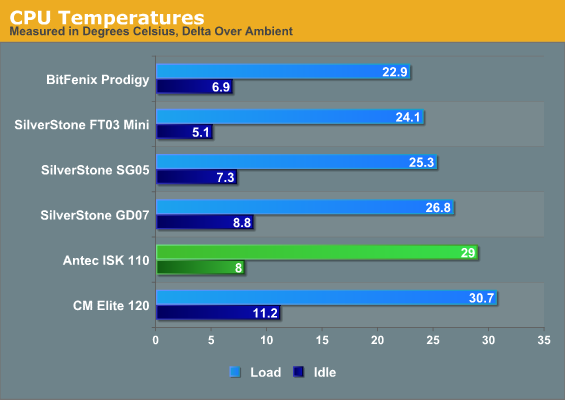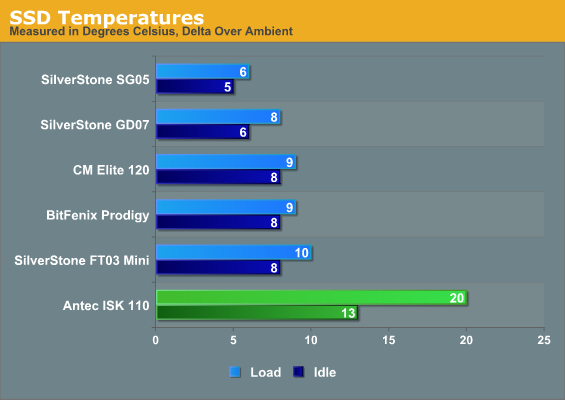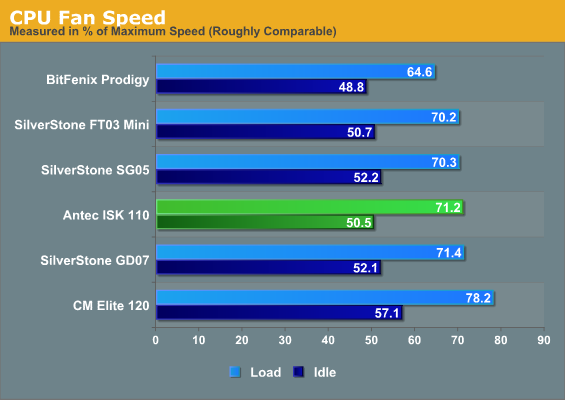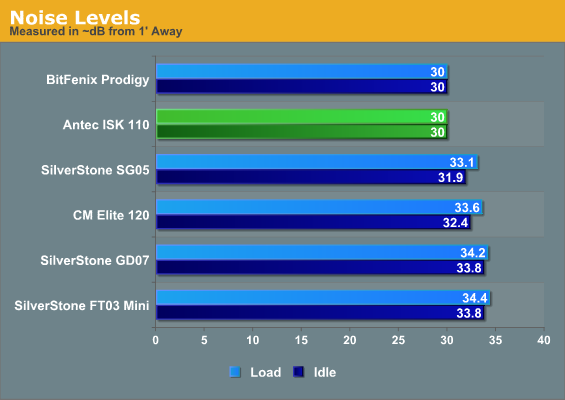Antec ISK 110 VESA Case Review: Just About As Small As It Gets
by Dustin Sklavos on August 31, 2012 12:01 AM EST- Posted in
- Cases/Cooling/PSUs
- Mini ITX
- Antec
Noise and Thermal Testing
Without anywhere to put a dedicated graphics card in the Antec ISK 110 VESA, testing winds up being a bit more truncated than we'd expect. In a way some of these results are going to seem academic, essentially reviewing SilverStone's NT07-1156 heatsink/fan unit about as much as the case itself.
Ambient temperature during testing hovered between 24C and 25C.


These test results are actually a little more interesting than I'd expected; despite the ventilation, the heatsink has to do all the work of keeping the CPU cool. With no directed airflow in the system outside of that, the processor actually runs notably warmer than in larger, more closed off cases with more directed airflow. Only the Cooler Master Elite 120, with its poor intake airflow, posts a worse temperature on the processor, but those thermals are still perfectly reasonable.
On the other hand, the SSD in the ISK 110 is running much hotter than I'd like. The bottom panel really needs more ventilation than it has; a peak temperature in the mid-40s is still within spec for most 2.5" drives, but that's with just a single SSD. A second drive, especially a mechanical hard drive, could bump thermals up a few degrees and start edging pretty close to 50C, which is spec for some drives.

Fan speed in the ISK 110 is middle of the road. As long as you're using a processor that runs fairly cool you shouldn't have too many issues with it; we still have some headroom on ours.

The flipside to the Antec ISK 110 VESA's design is that while it relies solely on the heatsink/fan combo to actively cool the system, it also relies solely on the heatsink/fan combo to actively cool the system. That means with a unit like the SilverStone one we use, the ISK 110 VESA can run comfortably quiet even under load.










53 Comments
View All Comments
Anosh - Wednesday, November 7, 2012 - link
*exceptMadAd - Friday, August 31, 2012 - link
When do you think we might get a SFF forum to chat about all this?Laptops are so not SFF material and they drive out SFF chat.
MadAd - Saturday, September 1, 2012 - link
Would the SSD have been a bit happier had it been mounted the other side and not directly under the CPU plate?mariush - Saturday, September 1, 2012 - link
Where are the close up pictures of the power supply, both the external one and the internal board?Where are the close up pictures of the case, without anything shoved into it?
Oh there's two galleries...why the hell two separate galleries?
Why so much suck usability wise?
If I'm opening a gallery in a new tab, I get no link to go back to the article and I can't tell if there are other galleries. Luckily this is a fresh article so I clicked "Galleries" I saw the other gallery but if this was an older gallery I would have no way to tell if there are other galleries.
The external power supply one is made by Delta so that somewhat guarantees it's a quality one but the internal board is also important to see for some people.
I can barely see from the picture it's a 19v adapter - what's the point of large pictures if you don't get more information from it than what you can see in a thumbnail?
Why no close-up pictures of the actual pcb - that's the real power supply (well, dc-dc converter) !.. Why no test of what they say, is it really 92% efficiency? I doubt it, 92% efficiency is probably just for the external adapter.
Very long USB and sound cables... I can't figure out why they have to be so long in such case.
mariush - Saturday, September 1, 2012 - link
I apologize. There IS a link back to article in the galleries, called "Back to post" ... but it's positioned in such a way that I confused it to a "Previous picture" , "Next picture" type of link.twinclouds - Saturday, September 1, 2012 - link
I have been using the case of Shuttle X27 for some time. I took out the original board and added a more powerful ITX board. The size of the case is 2.9"x7.2"x10.5". It is actually smaller than the Antec case mentioned here in volume. It is narrower and longer and looks better for me when in horizontal position. In addition it has the space for a slimline CD/DVD drive. The only inconvenience is that it does not have a flash card reader. I wish someone can build such a case for retail.herrdoktor330 - Sunday, September 2, 2012 - link
Here's a thought: packing a bigger AMD APU (think the upcoming Trinity A10-5800K) into this size case and doing a modest overclock to the APU's GPU. You could do some modest gaming @ 720p on a rig like that in a profile smaller than the Xbox 360. The only bottleneck is the external power supply. So I started looking at the manufacturer's website of the power brick and model number (delta electronics - adp-90CB(?)-AB). I couldn't seem to find anything on the delta electronics website matching the CB part of the model number. That designation doesn't seem to match any of the laptop or mini-pc brick model numbers. So here's my questions:1) Is there any information on the output connections on the adp-90CB(?)-AB vs the ADP-150BB B. I'm still googling up information on the topics of outputs, allowable voltages, and such to answer my own question. But maybe someone here knows the answer?
2) Assuming you could jimmy up a compatible brick, could the internal PCB handling power in the ISK-110 be able to handle the extra 60w and 2.6 times the amps a bigger brick would offer?
for reference:
http://www.delta.com.tw/product/ps/adapter/adapter...
mariush - Sunday, September 2, 2012 - link
The delta brick is a 19v 4.77a or something, for a total of 90 watts. You can see the rating (barely) in one picture.The case has internal dc-dc converters that generate the 3.3v , 5v and 12v out from that 19v with about 90% efficiency, so the system sees about 85 watts in total on those 12v, 3.3v and 5v outputs.
I already complained about no close-up pictures of that dc-dc converter inside the case, and this is one of the reasons: I can't see what ICs are used, how the voltages are generated.
The most used voltage will be 12v so the internal board probably is configured for 12v @ 8A max (12v x 8a = 96 watts), 3.3v @ 4 A, 5v @ 4A or something like that.... but all added up can't exceed 90w, the external brick's rating.
You may be able to replace the brick with one rated for more current as long as it's still 19v (for example use a 120w brick with 19v output) but in the end it depends on the circuit on the board inside the case if the chips can output more current on 12v.
They may be unable to output more than 6-8A or they may be locked to a maximum value to keep the board cool. But if you're lucky, they may be able to output 10-12a reliably on 12v alone, possibly with a heatsink applied on them.
There's no overload test on the power supply, no information in this review. Which sucks.
herrdoktor330 - Sunday, September 2, 2012 - link
Thanks for the feedback. Good thought on the locked amp values too. I didn't think about that.Again, I'm still doing my own research into the matter. But you're right... it'd be cool if the Anantech crew looked into mods like that. But maybe there's some other group that may try this.
I guess if one was inclined, this thing COULD take an A10-5700 when they get released without any power brick mods. But still, it'd be nice if you could work with this form factor but have a little more power at your disposal.
Manyak - Thursday, September 6, 2012 - link
I just got done building 12 systems for an office using this case. They're using i3-2100's, ASUS P8H77-I motherboards, 2x4GB DDR3-1600, and Crucial M4 SSD's.1: It is possible to install motherboards without removing the PSU. You have to put the right side of the motherboard in first (the part closest to the front of the case), and kind of squeeze it in under the front panel USB block as much as possible. Then lower the back end down into the case. If the I/O plate has tabs sticking out into the case it'll make it hard, but you can just bend it outwards a bit with your finger while pushing the motherboard down. It's tricky, but it works.
2: You installed the SSD in the slot that sits directly behind the CPU, and there's no insulation between it and the motherboard. If you install it in the other slot I think it should run a little cooler.
Also, you should take a look at the Morex M350 case. In theory it's a similar design to this one - completely minimalistic, with nothing but mesh - but it's even smaller. Yet it manages to give you a much neater build, and HDD airflow is a lot better.